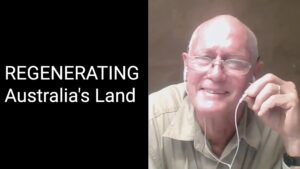REGENERATING Australia’s Land: Insights with Chris Henggeler
In a compelling episode of Let’s Climunicate, host Dr. Alberto Troccoli sat down with Chris Henggeler, a pioneer in land regeneration at Kachana Station in the Kimberley region of Western Australia. With over 40 years of hands-on experience, Henggeler has demonstrated how degraded landscapes can be restored through collaboration with nature. His approach, influenced by traditional knowledge and regenerative land management techniques, presents a practical blueprint for addressing climate change, desertification, and biodiversity loss.
The Challenge and Opportunity of Land Regeneration
Henggeler’s journey began with a severely degraded landscape, stripped of biodiversity and unable to support traditional agriculture. Rather than accepting this as an irreversible consequence of human impact, he committed to revitalising the ecosystem. Drawing on the principles of Alan Savory, Elaine Ingham, and Fred Provenza, he implemented regenerative farming techniques that mimic natural processes—utilising controlled livestock movements to improve soil health, restore vegetation, and enhance ecosystem function. His work demonstrates that even the most depleted landscapes can recover when ecological processes are restored.
Beyond Conventional Agriculture: A Sustainable Approach
Unlike intensive cattle farming, which often prioritises short-term yield at the expense of long-term sustainability, Henggeler’s approach balances productivity with environmental health. His focus on microclimate management and biodiversity restoration challenges the idea that agriculture and conservation are inherently in conflict. Instead, he advocates for scaling regenerative practices as a means to improve food security, enhance water management, and strengthen climate resilience. His work serves as a model for sustainable land stewardship, demonstrating that working with natural systems rather than against them leads to long-term ecological and economic benefits.
The Role of Policy and Community Action
A key takeaway from the discussion was the need to bridge the gap between grassroots regenerative efforts and broader policy support. Large-scale land restoration cannot rely solely on individual farmers—it requires collaboration among land managers, scientists, policymakers, and local communities. Henggeler emphasises that public engagement and legislative support are essential to ensure that regenerative practices are not only implemented but also sustained over the long term. Without systemic support, efforts to heal the land remain fragmented and limited in scale.
A Call to Action: Reconnecting with the Land
Henggeler’s story is not just an environmental success—it is a call to action. He urges individuals to become more aware of where their food comes from, support local regenerative farmers, and recognise water as a critical shared resource. His work highlights the importance of shifting our relationship with nature from one of extraction to one of regeneration and coexistence.
For those interested in learning more, Kachana Station provides a living example of how regenerative land management can transform degraded landscapes into thriving ecosystems. By studying and supporting such efforts, individuals and communities can contribute to a more resilient and sustainable future.




